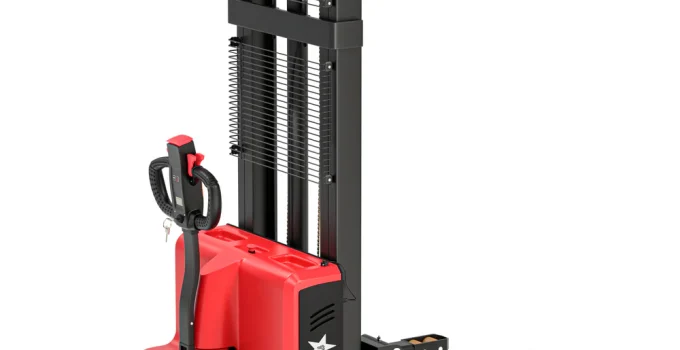Electric stackers have become a go-to solution for efficient and sustainable material handling across various industries. These compact machines are specifically designed to streamline the movement and stacking of pallets, making them an ideal choice for warehouses, manufacturing units, and retail spaces. This article explores the key advantages of using electric stackers and why they are gaining popularity in modern material handling operations.
Compact Design for Space Optimization
One of the most notable advantages of Electric Stacker is their compact design. These machines are engineered to fit into tight spaces, allowing operators to navigate narrow aisles and congested warehouse layouts with ease. Unlike larger equipment such as forklifts, electric stackers are lightweight and easy to maneuver, making them perfect for facilities with limited space. Their small footprint ensures that businesses can maximize storage capacity while maintaining smooth workflows.
Lower Noise Levels for Indoor Use
Electric stackers operate with significantly lower noise levels compared to traditional gas-powered equipment. This makes them ideal for indoor environments where noise control is a priority, such as retail stores, food storage facilities, and e-commerce warehouses. The quiet operation of electric stackers not only improves the working conditions for employees but also minimizes disruptions in environments where noise can be a concern, such as hospitals or offices with warehouse components.
Eco-Friendly and Energy-Efficient Operation
In today’s eco-conscious world, businesses are increasingly seeking sustainable solutions, and electric stackers fit the bill perfectly. Unlike gas or diesel-powered alternatives, electric stackers produce zero emissions, making them environmentally friendly. Additionally, these machines are energy-efficient, consuming less power to perform daily tasks. This not only reduces the carbon footprint of material handling operations but also helps companies comply with stricter environmental regulations.
Reduced Operational Costs
Electric stackers offer significant cost savings compared to traditional material handling equipment. Their energy-efficient design leads to lower electricity consumption, reducing operational expenses over time. Maintenance costs are also lower since electric stackers have fewer moving parts and simpler machinery compared to forklifts. Businesses can save on fuel, servicing, and replacement parts, making electric stackers a cost-effective choice for both small and large-scale operations.
Ease of Use and Operator Comfort
Another major benefit of electric stackers is their user-friendly design. These machines come equipped with intuitive controls, making them easy to operate even for less experienced staff. Many models include ergonomic handles and adjustable features that reduce operator fatigue during long shifts. The smooth and precise movements of electric stackers enhance accuracy when stacking or transporting materials, improving overall productivity.
Enhanced Safety Features
Electric stackers are designed with safety in mind, making them a reliable choice for material handling. Features such as automatic braking systems, load sensors, and emergency stop functions help reduce the risk of accidents. Their compact size and controlled speed make them less likely to cause collisions in busy warehouse environments. Additionally, electric stackers are easier to stabilize than larger equipment, minimizing the risk of tipping over when carrying loads.
Versatility Across Industries
Electric stackers are versatile machines suitable for a wide range of applications. They are commonly used in warehouses to stack pallets, in retail settings to transport goods, and in manufacturing plants for material movement. Their adaptability makes them an excellent investment for businesses operating in diverse industries, as they can handle various tasks without the need for additional equipment.
Improved Productivity and Efficiency
By streamlining material handling tasks, electric stackers significantly boost productivity. Their precision and ease of maneuverability enable operators to complete tasks quickly and efficiently. Whether it’s moving pallets, loading trucks, or stacking materials at different heights, electric stackers enhance workflow and reduce downtime. This improved efficiency translates to better overall performance for the business.
Minimal Maintenance Requirements
Electric stackers are built for reliability and durability, requiring minimal maintenance compared to traditional gas-powered equipment. Regular checks and occasional battery servicing are usually sufficient to keep the machine running smoothly. This low-maintenance aspect ensures that businesses can focus more on their operations without worrying about frequent breakdowns or costly repairs.
Cost-Effective for Small and Medium-Sized Businesses
For small and medium-sized enterprises (SMEs) with limited budgets, stacker lift, electric stackers are an ideal solution. Their lower upfront cost, coupled with reduced operational and maintenance expenses, makes them a financially viable option. These businesses can enjoy the benefits of efficient material handling without the need for larger, more expensive machinery.
Conclusion
Electric stackers are revolutionizing material handling with their compact design, quiet operation, and cost-saving benefits. They offer a versatile and environmentally friendly solution for businesses seeking efficiency and sustainability in their daily operations. Whether you’re running a small warehouse or managing a large distribution center, electric stackers provide an excellent balance of performance, affordability, and safety.



